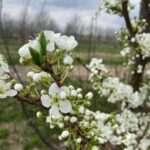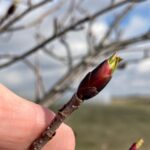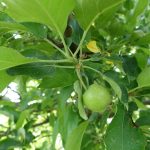Spring temperatures and the season so far It seems like it’s been warm and that we’re way ahead of normal. But the data paint a slightly different picture. First, let’s not talk too much about “normal”. In the last 10 years or so that I’ve been plotting these data, EVERY year has been warmer than[Read More…]
With many orchards suffering severe frost damage last year, our expectation is for very heavy flowering this spring. We’ll talk more about thinning next time, but it’s a pretty safe prediction that flowering will be heavy and so growers will really need to have their act together regarding thinning. So make sure now that your[Read More…]
Warm temperatures over the last week or so have accelerated growth rapidly. In Lafayette, apples are nearing green tip, and strawberries at full bloom. Blackberries are pushing half-inch green. Further south in the state, temperatures are in the mid 70’s, apricots are in full bloom and peaches not quite at pink (thanks to Applacres for[Read More…]
The USDA Coronavirus Assistance Program (CFAP) is accepting applications up until tomorrow (Sept. 11). These should be made by contacting a USDA-FSA office. Producers of specialty crops are eligible for CFAP payments for losses for the following three categories: Had crops that suffered a five percent-or-greater reduction in sales price between mid-January and mid-April as[Read More…]
This just in from Steven Brown, State Executive Director for USDA’s Farm Service Agency in Indiana CFAP provides direct relief to agricultural producers who faced price declines and additional marketing costs due to COVID-19. In Indiana, we have already approved 15,034 applications and disbursed $164,250.055 as of July 27, 2020. I know many of our farmers[Read More…]
Small farmers are moving loads of product via online sales. Let’s talk about how, what’s working, and what you need to sell online amid a pandemic. Hoosier Young Farmers Coalition is hosting farmer-to-farmer webinars. Each one will feature a different farmer sharing the tools that are being used to sell online. About these Events You’re[Read More…]
The summer meeting is going ahead on June 30, but we’re changing the format from in-person to a virtual meeting. Again this year we will have a combined meeting with the vegetable growers and farm marketers. We will be hosted by Beasley’s Orchard, Danville IN. Beasley’s management consists of a vibrant young team comprising Calvin[Read More…]
Apple crops are looking dismal around the state. Here in Lafayette we probably have about 20% of a crop, and I’m hearing similar things around the state. With a short crop, growers need to decide whether it’s worth protecting the fruit that are present with a full pesticide program, or writing the crop off and[Read More…]
Are you a produce grower? Have you thought about produce your own value-added products that increase the value of your fresh produce? What are the challenges for you to start or expand your value-added business? How does COVID-19 affect your business? We would like to invite you to participate in the online survey to share[Read More…]
Spring’s arrival brings many wonderful experiences – including the opportunity for local consumers to pick farm-fresh produce onsite, learn more about local outlets through agritourism and enjoy time outdoors. The U-Pick season, as it’s known, is just around the corner for strawberries, blueberries, cherries and more. Now is the time to implement best practices to[Read More…]




